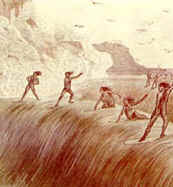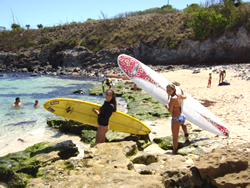|













| |
Geschiedenis
van het surfen
Surfen
Surfen
(of golfsurfen)
is de meest oorspronkelijke vorm van boardsporten die er is. Sporten als
windsurfen, maar ook skateboarden,
snowboarden en wakeboarden zijn hieruit ontstaan.
Golfsurfen is het
principe van voortstuwing op een plank door gebruik te maken van de golfslag van
de zee. Door energie
van stormen op de oceaan ontstaat deining op de oceaan. Deze deining verplaatst
zich richting de kusten en neemt geleidelijk in energie toe. Als al deze energie
bij de kust komt wordt deze afgeremd en wordt de energie omhoog gedwongen
waardoor golven?
ontstaan. Een surfer gebruikt de voorzijde van de golf om zijn plank voldoende
vaart te geven om staand op de plank met de golf mee te kunnen rijden.
|

|
|

|
Het golfsurfen is
waarschijnlijk duizenden jaren geleden ontstaan in PolynesiŽ.
Deze sport is door de PolynesiŽrs meegenomen naar Hawaii
en is daar bekend geworden bij het grote volk. Vooral de Olympisch zwemmer Duke
Kahanamoku heeft de sport enorm bekend gemaakt.
De sport is in de loop der jaren veel veranderd.
De massieve balsahouten planken werden eerst vervangen door holle planken en
vandaag de dag bestaat een plank uit een soort piepschuim met daarom heen een
glasvezeldoek en een kunstharslaag. Ook worden er kleinere boards gemaakt
waardoor de bewegingsvrijheid enorm wordt vergroot.
[Uit
de wikipedia-encyclopedie; www.wikipedia.com]
|
|
Geschiedenis van vrouwelijke
surfers |
|
Surfing
is often thought of as a male sport, but in fact women have enjoyed
surfing since the days of ancient Hawai'i, and in California since the
early 1920's. Today, you can find "wahine" surfers in every
surfing country. Like the men, they range from amateurs to accomplished
professionals, competing for cash prizes and corporate sponsors.
One of the
earliest women surfers from California was Mary Ann Hawkins. She
was the first of a long line which stretched down in the 60's to Marge
Calhoun and her daughters, and naturally to Linda Benson,
followed by some of the top pro surfers of today. |

surfing women in the old
days..... |
|

|
The first
Australian to ride a surfboard was, in fact, a woman: Isabel Letham,
who rode tandem with Duke Kahanamoku when the Duke introduced Australians
to board riding at Freshwater in 1915. In the early60's, Australians Phyllis
O'Donnell and Gail Couper were very influential for women's
surfing.
Surfing
among women really became popular with the arrival of the Hollywood
movies, like Gidget Goes Hawaiian, or Ride The Wild Surf. Linda Benson
did the surfing action sequences for Gidget Goes Hawaiian, and while this
is among her more memorable surfing experiences, she was Pacific Coast
Women's Champion in 1959, 1960 and 1961. In 1963, at the age of 18, Linda
was one of the best-known young women in surfing. |
|
[Voor
het hele artikel kun je naar surf.about]
|
|
Hawaiian roots of surfing |
|
Although
no one knows for sure exactly where and when stand-up surfing began, there
is no doubt that over the centuries the ancient sport of "he'e
nalu" (wave-sliding) was absolutely perfected by the Kings and
Queens- and the men and women of the Sandwich Isles, long before the 15th
century AD. Their fortuitous position by way of longitude and latitude
brought the great waves of the Pacific in all shapes and sizes to these
islands.
He'enalu, a
Hawaiian term adopted by ancient poets to describe their spectacular sport
of surfing, is a word rich nuance. Like many subtleties expressed by this
highly-evolved civilization, the world for this popular form of recreation
is rich in what Hawaiians call kaona, or hidden meaning. The first half,
"he'e," can mean for instance, "to change from a solid to a
liquid form, or to run as a liquid"; the second part,
"nalu" can refer to the surfing motion of a wave, or the foaming
of a wave, hence he'enalu, wave-sliding. |
Klik
hier als je een aantal Hawaiaanse woorden wilt leren!

|
|

|
Hawaiians attached great
mystique to the ocean and her moods. Not unlike the Eskimo, who utilizes
several hundred words to relate forms and concepts of ice and snow, the
Hawaiian people likewise assigned numerous persona and poetic metaphors to
the ever changing sea, the kai.
All these natural forms had
a significant effect on he'enalu, as any modern day surfer will readily
testify. Hawaiians even had an appropriate word, hopupu (ho-poo-poo), that
referred to a state of being stoked, or emotionally excited about
something. In his important manuscript Traditions of Hawaii, the 19th
Century Hawaiian scholar Kepelino Keauokalani (kay-ow-o-ka-la-ni),
recalled that "during November, which in the Hawaiian calendar is
called 'ikuwa,' in honor of 'deafening' wind, storms and waves that occur
during that month, early Hawaiians would become particularly hopupu." |
|
[Voor het hele
artikel kun je naar surf.art] |
|
Geschiedenis van het merk O'neill |
|

|
In 1952, Jack opened his first surf
shop in a garage across the Great Highway in San Francisco, a sand dune
away from his favorite bodysurfing break. There he sold his first
wetsuits, a few vests he made from gluing together pieces of neoprene.
From that very garage Jack expanded the average surfer's playground from
Steamer Lane to J-Bay, Antarctica and those fun reefbreaks off the coast
of Iceland. Thanks to Jack O'Neill, "It's always summer on the
inside." |
| "Surfing
in the 50s was great," says Jack. "You knew everybody and we all
took turns on the waves." But surfing in the 1950s also meant short
sessions due to the cold water temperatures, and surfers tried anything to
stay warm. "I remember one guy that tried to keep warm with a navy
jumper and he put Thompson's Water Seal on it," recalls Jack. |
 |
| [Voor
het hele artikel kun je naar O'neill] |
Copyright © 2003 [Surfing Girlz]. Alle rechten voorbehouden.
Laatst bijgewerkt: 01 sep 2004 16:07:59 .
|